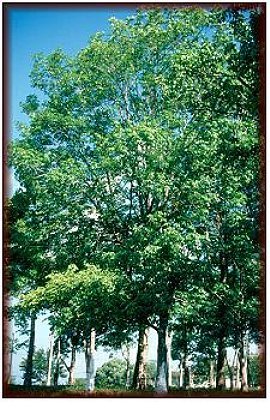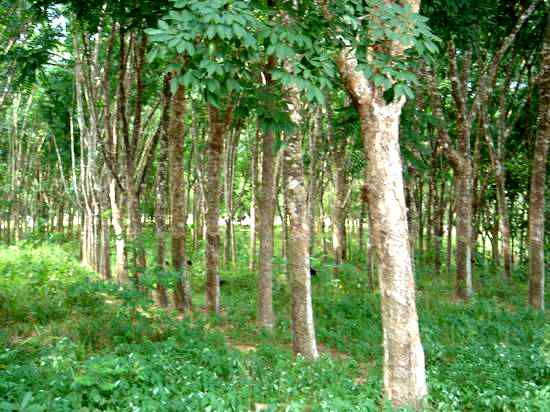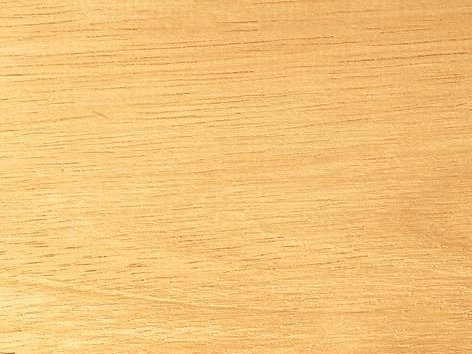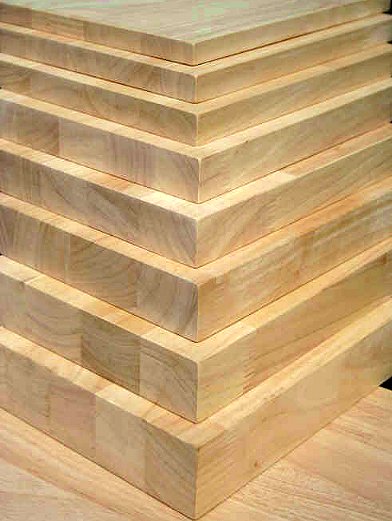
Hevea Brasiliensis Hardwood
Species Identity: Hevea Brasiliensis
Common Names: Rubberwood, Parawood
Compare to: Northern Red Oak
Hevea Brasiliensis is a hardwood from the Maple family of hardwoods & has very little tendancy to warp or crack, is eco-friendly & is often the most misunderstood species of wood in the furniture industry. The name Rubberwood invokes a variety of misconceptions as to it's features and to it's durability. Rubberwood (also called Parawood in Thailand) is the standard common name for the timber of Hevea Brasiliensis.
In fact, Hevea Brasiliensis is one of the more durable lumbers used in the manufacturing of today's home furnishings. As a member of the Maple family, Hevea Brasiliensis has a dense grain character that is easily controlled in the kiln drying process. Hevea Brasiliensis has very little shrinkage making it one of the more stable construction materials availabe for furniture manufacturing.
As a Maple hardwood, Hevea Brasiliensis is a sap producing species. In the case of Maple, it is sap; in the case of Hevea Brasiliensis, it is latex.
Hevea Brasiliensis Plantation

There is one more important feature of Hevea Brasiliensis that is very important in today's world. Hevea Brasiliensis is the most ecologically "friendly" lumber used in today's furniture industry. After the economic life of the Rubber tree, which is generally 26-30 years, the latex yields become extremely low and the planters then fell the Hevea Brasiliensis trees and plant new ones. So, unlike other woods that are cut down for the sole purpose of producing furniture, Hevea Brasiliensis is used only after it completes it's latex producing cycle and dies. This wood is therefore eco-friendly in the sense that we are now using what was going as waste.
Do not mistake the name Hevea Brasiliensis when it comes to its quality features.
Compare to: Northern Red Oak
Hevea Brasiliensis Hardwood Grain

Properties of Hevea Brasiliensis:
· Density(kg/M3 at 16%MC ---------------------------- 600-650
· Tangential Shrinkage Coefficient (%) ------------- 1.2
· Radical Shrinkage Coefficient (%) ----------------- 0.8
· Hardness(N) ----------------------------------------------- 4,350
. Bending Strength ------------------------------------------9572 lbf/in2
· Static Bending, N/mm at 12% MC ------------------ 66
· Modulus of elasticity,n/mm at 12%MC ------------ 9,700
. Screw Holding Avg Radial Tengential value ------ 267kg
. Compare to: Northern Red Oak
Hevea Brasiliensis Hardwood Plywood

General Information:
The Hevea Brasiliensis tree reaches a height of over 30m, and is from the same family as Maple. They both produce sap. The sap from rubber trees is known as latex. Hevea Brasiliensis trees produce all the latex in the world for all rubber-based products.
The economic life of a Hevea Brasiliensis tree (i.e. number of years it produces latex) is roughly 25 to 30 yrs. After the trees die, they are felled and new ones are planted.
Historically, the felled timber was used as firewood to fuel brick-making and tobacco-curing. The commercial value of Hevea Brasiliensis was negligible till about 15yrs ago. Dramatic changes in world economy plus the occurence of natural disasters in some parts of the world necessitated the need for quality alternative hardwood timbers.
references:
(1) Wood handbook--Wood as an engineering material. Gen. Tech. Rep. FPL-GTR-113. Madison, WI: U.S. Department of Agriculture, Forest Service, Forest Products Laboratory. 463 p.
(2) International Trade Centre UNCTAD/GATT (ITC) (Division of Product and Market Development)
(3) Experts.about.com/q/Decorating-Furniture-2033/Rubberwood-furniture.htm
(4) Homedecodirect.com/Articles.asp?ID=114
(5) Weyerhaeuser Forest Products Laboratory. 1999.
(6) Statistics on Commodities. Ministry of Primary Industries Malaysia, Kuala Lumpur. July 1994.
(7) Rubberwood, A study of World Supply Potential. A Report prepared by INDUFOR Oy Helsinki for International Trade Centre, UNCTAD/GATT 1993b.
(8) Barlow C. 1978. The Natural Rubber Industry. Its Development, Technology and Economy in Malaysia, Oxford University Press, K.L. 500 pp.
(9) Gan L.T., Ho C.Y. and Chew O.K. 1985. Heveawood: Sawntimber Production and Recovery Studies. International Rubber Conference 1985, Kuala Lumpur.
(10) Ho K.S. and Choo K.T. 1983. Processing of rubberwood. In Proceedings of Rubberwood Utilization Seminar 1982. Ed. Hong L.T. FRI Report No: 28 pp. 11-19.
(11) Hong L.T., Mohd. Ali Sujan, Tan A.G., and Daljeet Singh K. 1982. Preservation and protection of rubberwood against biodeteriorating organisms for more efficient utilization. The Malaysian Forester 45:299-315
(12) Hong L.T. and Wong W.C. 1986. Commercialization of Lesser Known species - A case study on rubberwood. Paper presented at IUFRO 18th. Congress Ljubljana, Yugoslavia. 7-12 September 1986.
(13) Hong L.T. & Sim H.C. Eds. 1994. Rubberwood - Processing and Utilization. Malayan Forest Records No. 39, Forest Research Institute Malaysia, 249 pp.
(14) Lee Y.H., Engku Abdul Rahman Cik and Chu Y.P. 1979. The Strength Properties of Sime Malaysian Timbers. Malaysian Forest Service Trade Leaflet No. 34.
(15) Lew W.H. and Sim H.C. 1983. Rubberwood - Present and Potential Utilization. In Proceedings Rubberwood Utilization Seminar 1982. Ed. Hong L.T. FRI Report No: 28.
(16) Norini Hj. Haron, Ismariah Hj. Ahmad and Ahmad Shakri Mat Seman. 1990.
(17) Proceedings International Rubberwood Seminar. Ed. Hong L.T. et al, FRIM, Kuala Lumpur. pp 55-69.
(18) Ong M.S. 1983. Rubberwood Utilization - Regulatory Aspects. In Proceedings of Rubberwood Seminar 1982. Ed. Hong L.T. FRI Report No: 28 pp. 71-77.
(19) Ooi, S.H. 1987. Development strategies for the rubberwood Processing Industry. In Proceedings Rubberwood Utilization Seminar 1985, FRIM, Kuala Lumpur. pp 72-93.
(20) Peel, J.D. 1958. The suitability of rubberwood as a raw material for fibreboard. The Malayan Forester 21:112-115.Peel, J.D. and Peh T.B. 1960. Para rubberwood (Hevea brasiliensis Muell. Ang.) for pulp and paper manufacture: an account of laboratory experiments. Malayan Forest Research Pamphlet No: 34. FRI, Kepong, K.L. 20pp.
(21) Salleh Mohd. Nor. 1987. Rubberwood: The Present and Future Furniture Timber. Paper presented at Woodmac Asia Conference. Singapore, 30 September -1 October 1987.
(22) Ser C.S. 1990. Rubberwood Resource in ASEAN and the Potential for its wider Utilization. In Proceedings International Rubberwood Seminar. Ed. Hong L.T. et al, FRIM, Kuala Lumpur. pp 27-39.
(23) Suherman 1987. Proceedings of the Seminar on the Utilization of rubberwood for the Development of Downstream Industries. ISA, Indonesia, as cited in Ser (1990)
(24) Rubberboard.org.in